Apple Macbook Pro 15 2018 Apple Computer Graphic Design
At a Glance
- Apple in November 2020 updated the MacBook Air with the Apple M1 chip, shifting away from Intel processors and graphics options. The MacBook Air starts at $999 and includes the M1 chip with an 8-core CPU, a 7- or 8-core GPU, and a 16-core Neural Engine for machine learning.
Current Specs
- 13" screen size
- 2560 x 1600 Retina display with True Tone
- Apple M1 chip with 8-core CPU and 7- or 8-core GPU
- 8 or 16 GB of RAM
- Up to 2 TB SSD
- Touch ID
- Thunderbolt 3/USB 4
- Scissor-switch Magic Keyboard
Models
13.3-inch with 2560 x 1600 Display:
- $999: M1 chip (7-core graphics) & 256 GB storage
- $1,249: M1 chip (8-core graphics) & 512 GB storage
Should You Buy the MacBook Air?
The MacBook Air was among the first of Apple's Macs to make the transition to Apple silicon, featuring significantly improved performance and battery life in a slim, fanless design. Announced in November of 2020, the MacBook Air is now over a year old, with a new model being expected in 2022.
Apple has updated the MacBook Air erratically in recent years, releasing two new models in 2020 and with no clear pattern prior to that, although the device has been updated every year since 2017. Now that Apple controls its own custom silicon for the MacBook Air, as opposed to using Intel processors, it is likely that the MacBook Air will see updates on a more regular basis in years to come.
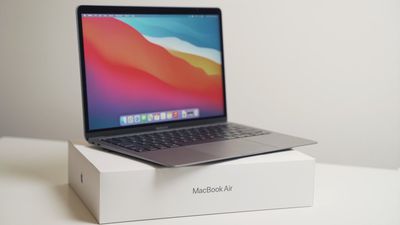
There have been clear signs that an updated MacBook Air with a number of upgrades and improvements is on the way, and rumors suggest that the model will arrive in mid to late 2022.
Updated MacBook Air models are believed to be several months away, meaning that it is only advisable to buy a MacBook Air if you urgently need a new machine. For most people, it will likely be better to wait until new models arrive.
While the MacBook Air seems to be the best Apple laptop for portability and price, users who require slightly better performance and battery life, as well as the Touch Bar, should consider the M1 MacBook Pro, which starts at $1,299.
What's Next for the MacBook Air
Apple is working on a thinner, lighter version of the MacBook Air that will have thinner bezels than the current model, and which is expected to launch in 2022. Rumors suggest that it will be modeled after the 24-inch iMac, featuring off-white bezels and a chassis that comes in multiple iMac-like colors.
Design wise, it will be similar to the new MacBook Pro, but it will feature a thinner body. Unlike the current MacBook Air, it is not expected to feature a wedge design, and there's a possibility that Apple will once again remove the "Air" labeling and revert to the "MacBook" standalone name.
The MacBook Air will have the same 1080p camera that's in the MacBook Pro, but it's not yet clear if it will feature a notch. One rumor has said the machine would have the same notch as the MacBook Pro, but that would look more unusual with off-white bezels. To go along with the off-white bezels, the MacBook Air is expected to feature an off-white keyboard that has the same full-size function keys as the MacBook Pro.
There will be no SD card slot or HDMI port to differentiate it from the MacBook Pro models, but the MacBook Air will have a MagSafe charging port and several USB-C ports, along with a mini-LED display. Bloomberg's Mark Gurman says that the next-generation MacBook Air will feature the biggest redesign to the Air lineup since 2010, when 11 and 13-inch models were introduced.
Apple is developing a new "M2" chip for the MacBook Air. The M2 will not be as powerful as the M1 Pro and M1 Max, and will instead be an upgraded version of the lower-power M1 chip. The M2 chip is expected to feature the same number of computing cores as the M1 (eight), but it will run faster. It is also expected to have improved graphics with nine or 10 GPU cores, up from seven or eight in the current M1 MacBook Air.
Release Date
Apple analyst Ming-Chi Kuo says that mass production will begin on the new MacBook Air in the late second quarter or early third quarter of 2022. This would suggest a launch sometime around September 2022, but leaker Dylandkt has said the MacBook Air will come in mid-2022.
Read More
For more on what to expect from the 2022 MacBook Air, make sure to check out our dedicated MacBook Air guide where we aggregate all of the rumors that we've heard so far.
The M1 MacBook Air
Contents
- Should You Buy the MacBook Air?
- What's Next for the MacBook Air
- Release Date
- Read More
- The M1 MacBook Air
- How to Buy
- M1 MacBook Air vs. MacBook Pro
- M1 MacBook Air Reviews
- Design
- Display
- Keyboard
- Touch ID
- Trackpad
- Ports
- M1 Apple Silicon Chip
- Unified Memory Architecture
- Speed Improvements
- Benchmarks
- GPU
- Neural Engine
- No Fan
- Running Apps
- Battery Life
- Efficiency Test
- Other Features
- Connectivity
- Speakers and Microphone
- FaceTime Camera
- Storage
- M1 MacBook Air
- M1 Mac How Tos
- MacBook Air Timeline
Apple in November 2020 refreshed the MacBook Air lineup with its new M1 chip, which is the first Apple-designed Arm-based chip. M1 chips replace the prior Intel chips, and bring major speed and efficiency improvements.
The M1 chip, which is Apple's first System on a Chip, features an 8-core CPU with four high-efficiency cores and four high-performance cores along with an integrated GPU that has up to 8 cores. The MacBook Air's CPU is up to 3.5x faster than the prior generation model, and the GPU is up to 5x faster.
Machine learning workloads are up to 9x faster so the MacBook Air is quicker at ML-based features like face recognition and object detection. With the M1 chip, SSD performance is up to 2x faster, thanks to a new storage controller, and the MacBook Air can be configured with up to 2TB of storage.
RAM maxes out at 16GB, and it is integrated directly into the M1 chip for a unified memory architecture that brings performance and efficiency improvements. Battery life in the MacBook Air is significantly improved, offering up to 15 hours of web browsing and up to 18 hours of video playback.
Most of the changes to the MacBook Air are internal, rather than external. There are no major design updates to the MacBook Air, and it continues to feature a tapered, wedge-shaped aluminum body with a 13-inch Retina display with slim bezels and a large Force Touch Trackpad. The MacBook Air comes in Space Gray, Silver, and Gold.
The 13-inch display features a resolution of 2560x1600, which is the same as the prior-generation model, but new is P3 Wide Color support for more vivid, true-to-life colors. It offers True Tone to match the white balance of the screen to the ambient lighting for a more natural viewing experience, and it supports up to 400 nits brightness.
Apple's M1 MacBook Air features a 720p FaceTime HD camera, which is the same as the camera in the prior model, but Apple says the M1 improves picture quality with better noise reduction, better dynamic range, and other features.
Like the prior model, the M1 MacBook Air has a Magic Keyboard with a refined scissor mechanism that's more reliable than the previous butterfly mechanism, offering up to 1mm key travel for a stable key feel.
The keyboard has been tweaked slightly and the function keys now include Do Not Disturb, Spotlight search, and dictation options, plus there's a new emoji Fn key. A Touch ID fingerprint sensor can be used in lieu of a password for unlocking the Mac, making purchases, and more, with Touch ID protected by the Secure Enclave.

The MacBook Air has two Thunderbolt 3/USB 4 ports that support up to a 6K external display, and it works with WiFi 6 or 802.11ax and Bluetooth 5.0. There are stereo speakers with wide stereo sound support, a three-microphone array, and a 3.5mm headphone jack.
Note: See an error in this roundup or want to offer feedback? Send us an email here.
How to Buy
Pricing on the MacBook Air starts at $999 for the M1 chip, 256GB of storage, a 7-core GPU, and 8GB RAM, with a higher-end $1,249 model available with 512GB storage, 8GB RAM, and an 8-core GPU. The MacBook Air is available for purchase from the online Apple Store and Apple retail stores. Apple in February 2021 began selling discounted refurbished versions of the M1 MacBook Air at prices starting at $849.
M1 MacBook Air vs. MacBook Pro
If you're trying to decide between purchasing the M1 MacBook Air or the M1 MacBook Pro, our Buyer's Guide goes through the similarities and the differences to help you figure out which machine will best meet your needs.
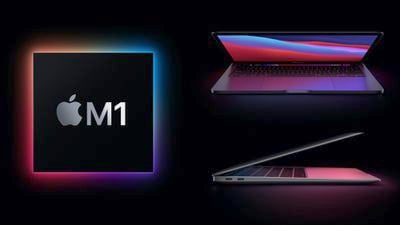
Issues
Some M1 Mac owners have reported problems with Bluetooth connectivity, which range from intermittent disconnects of wireless peripherals to non-functional Bluetooth connections. The issue was fixed in a subsequent software update.
M1 MacBook Air Reviews
Given the major speed improvements introduced with the M1 chip, reviews were unsurprisingly positive. The Verge called the MacBook Air the "most impressive laptop" that's come out in years, while Forbes said that it's similar to upgrading to a new iPhone processor - "everything seems preposterously fast and responsive."
Reviewers said that the MacBook Air performs like a "pro-level laptop," handling multiple apps with ease along with system intensive apps like Photoshop.
The MacBook Air has an "instant on" feature that's similar to an iPhone or an iPad, which reviewers were impressed with, and even though there's no fan, the MacBook Air stays cool and never got more than a little warm in reviewer tests.
Battery life didn't quite match Apple's maximums, but it did hit 8 to 10 hours of sustained work, which is far superior to the prior model. The one negative reviewers commented on was the FaceTime camera, which is still 720p and poor quality.
For more opinions on the MacBook Air and the other M1 Macs, make sure to check out our full M1 Apple Silicon review guide.
Design
The M1 MacBook Air does not have any external design changes compared to earlier models. It continues to be made from an Apple-designed aluminum alloy that uses 100 percent recycled aluminum and it is available in Silver, Space Gray, and Gold.

The MacBook Air features has a wedge shape, tapering from thick to thin toward the front of the device. At its thickest point, the MacBook Air measures in at .63 inches, and at its thinnest point, it measures in at 0.16 inches. It's just a little bit thicker than the 2019 MacBook Pro, which was .61 inches at its thickest point.

When it comes to dimensions, the MacBook Air is 11.97 inches long and 8.36 inches wide, and it weighs in at 2.8 pounds, 0.2 pounds less than the 13-inch MacBook Pro.
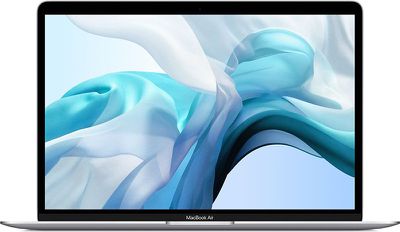
The M1 MacBook Air features a 13-inch display with slim black bezels, which is a design that's similar to the 13-inch MacBook Pro design.
Display
Since 2018, the MacBook Air has used a Retina display that is shaper, crisper, and clearer than the prior non-Retina display. The MacBook Air has a 2560 by 1600 resolution with 227 pixels per inch and more than 4 million pixels in total, with a maximum brightness of 400 nits.

The display in the MacBook Air supports True Tone, which is designed to tweak the color of the display to match the lighting in the room. True Tone works through a multi-channel ambient light sensor that's included in the MacBook Air models, which is able to determine both the brightness of the room and the color temperature.
After detecting the white balance, the MacBook Air is able to adjust both the color and intensity of the display to match the room's lighting for a more natural, paper-like viewing experience that also cuts down on eyestrain.
New for this model is P3 Wide color support, which brings more vivid, true-to-life colors and is an improvement over the sRGB color in the prior model. Wide color offers 25 percent more colors than sRGB.
Keyboard
The M1 MacBook Air uses the same redesigned Magic Keyboard that was first introduced in the 16-inch MacBook Pro and the prior-generation MacBook Air. The Magic Keyboard does away with the butterfly mechanism that Apple has been using since 2015 as it was riddled with issues that led to key failure due to dust and other small particulates.
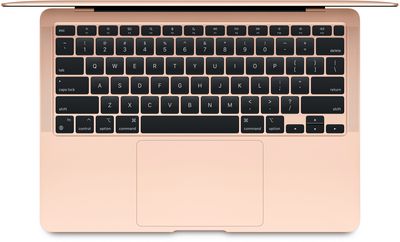
The scissor mechanism in the MacBook Air's keyboard offers 1mm of key travel and a stable key feel, plus it uses an Apple-designed rubber dome that stores more potential energy for a more responsive key press.
Apple tweaked the keyboard of the M1 MacBook Pro to change the available function keys. Launchpad and the keyboard brightness controls have been replaced with Spotlight search, dictation, and Do Not Disturb, plus there's an emoji Fn key.
The keyboard also features backlit keys controlled by an ambient light sensor to light up the keys in dark rooms.
Touch ID
The M1 MacBook Air has a Touch ID fingerprint sensor that's located next to the function keys at the top of the keyboard. Touch ID is powered by a Secure Enclave that keeps your fingerprint data and personal information safe.
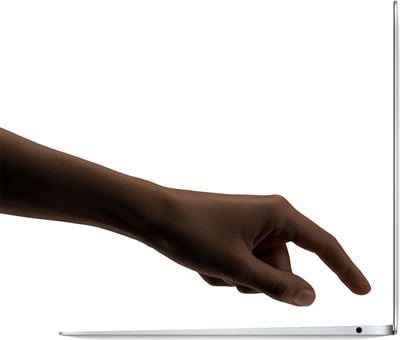
Touch ID on the MacBook can be used instead of a password, unlocking the Mac when a finger is placed on the sensor. It also replaces a password for password-protected apps, and it can be used to make Apple Pay purchases in Safari.
Trackpad
The MacBook Air is equipped with a large Force Touch trackpad that has no traditional buttons and is instead powered by a set of Force Sensors, allowing users to press anywhere on the trackpad to get the same response.
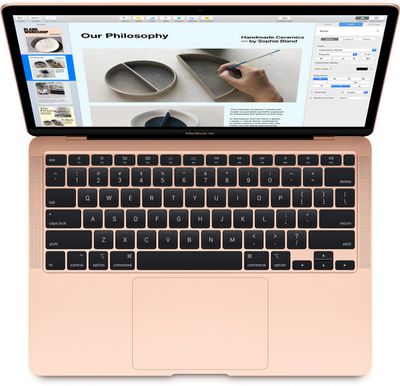
A Taptic Engine powered by magnets provides users with tactile feedback when using the trackpad, replacing the feel of a physical button press. The Force Touch trackpad supports a light press, which is used as a regular click, along with a deeper press or "force click" as a separate gesture that does things like offer up definitions for a highlighted word.
Ports
Two USB-C Thunderbolt 3/USB-4 ports are included in the MacBook Air. With Thunderbolt 3, the MacBook Air can support 4K, 5K, and 6K displays and connect to eGPUs for faster graphics capabilities when necessary.

6K display allows the M1 MacBook Air to work with the Pro Display XDR and other 6K displays. The MacBook Air supports a single 6K monitor, a single 5K monitor or two 4K monitors.
Apple says that the M1 MacBook Pro is limited to one display up to 6K resolution or two with 4K resolution, but using DisplayPort adapters, M1 MacBook Air and MacBook Pro models can run up to five external displays. This is only possible when using a mix of 4K and 1080p displays as the Thunderbolt ports do not have the bandwidth to run five 4K displays.
Along with the two Thunderbolt 3 ports, there's a 3.5mm headphone jack on the other side of the device. Other than that, there are no additional ports on the MacBook Air, with Apple having removed the USB-A ports and SD card slot seen in MacBook Air models prior to 2018.
M1 Apple Silicon Chip
The MacBook Air is one of the first Macs to be updated with an Apple-designed Arm-based chip rather than an Intel chip like prior MacBook Air models. These chips are called "Apple silicon," and the chip used in the MacBook Air is the M1.

The M1 is Apple's first System on a Chip designed for the Mac, which means it has the processor, GPU, I/O, security features, and RAM all one one chip that's inside the Mac. Apple says that this allows for better performance and power efficiency for longer battery life.
Like Apple's latest A14 chips, the M1 is built on a 5-nanometer process, which makes it smaller and more efficient than Apple's prior chips. It has 16 billion transistors, which Apple says is the most that it has put into a single chip.
Unified Memory Architecture
One of the features of the M1 is a unified memory architecture, or UMA, It unifies high-bandwidth, low-latency memory into a single pool. This means that the technologies in the M1 chip can access the same data without copying it between multiple memory pools for dramatic performance improvement across the entire system.
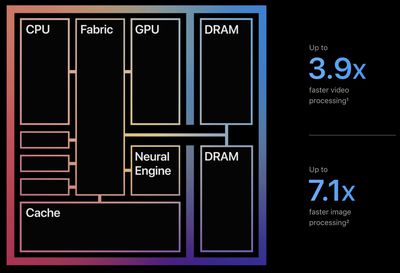
Video processing is up to 3.9x faster thanks to the UMA, and image processing is up to 7.1x faster.
Speed Improvements
The M1 features an 8-core CPU and an integrated 8-core GPU (there's also a 7-core GPU option as explained below). The CPU has four high-efficiency cores and four high-performance cores. When doing simple tasks like browsing the web or reading email the MacBook Air will engage the high-efficiency cores to preserve battery life, but for more system intensive tasks like photo and video editing, the high-performance cores are used.
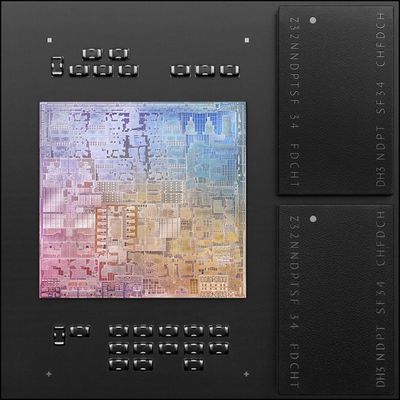
Compared to the high-performance cores, the high-efficiency cores use a tenth of the power while still delivering the performance that Mac users need for everyday tasks.
According to Apple, the M1 chip's CPU is up to 3.5x faster than the Intel chip in the prior MacBook Air, and GPU speeds are up to 5x faster. Base MacBook Air models come with an M1 chip that has a 7-core GPU, but the higher-end model with 512GB of storage comes with an 8-core GPU like the M1 MacBook Pro and Mac mini.
The M1 is designed to offer higher performance at every power level compared to competing laptop chips. It offers 2x faster CPU performance than the latest PC laptop chip while using 25 percent of the power. In GFX Bench 5.0 benchmarks, the M1 beat out the GTX 1050 Ti and the Radeon RX 560 with 2.6 TFLOPs of throughput.
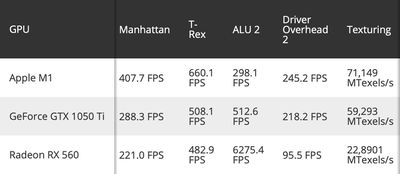
Benchmarks
In a Geekbench benchmark, the MacBook Air, which has a 3.2GHz base frequency, earned a single-core score of 1687 and a multi-core score of 7433, which makes it faster than the high-end 16-inch MacBook Pro models released in 2019. Those 16-inch MacBook Pro models were equipped with Intel's latest 10th-generation chips, but the just-announced M1 Pro and M1 Max MacBook Pro models will undoubtedly eclipse the MacBook Air by a significant margin.
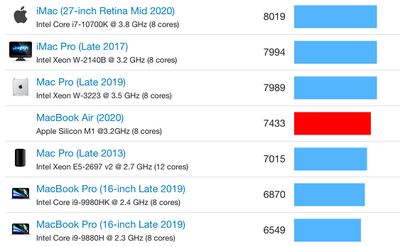
At its launch, the M1 chip offered single-core performance that was better than any other available Mac.
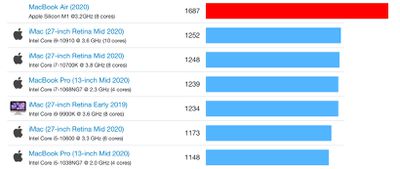
Even when emulating x86 under Rosetta 2, the M1 Macs were still faster than all previously released Macs. With Geekbench running through Apple's Rosetta 2 translation layer, the Macs achieve 78 to 79 percent of the performance of native Apple silicon code.

R23 Cinebench benchmarks of the M1 chip come in at 7508 for multi-core and 1498 for single-core. The benchmark is for the M1 MacBook Pro, but the MacBook Air has the same chip inside.
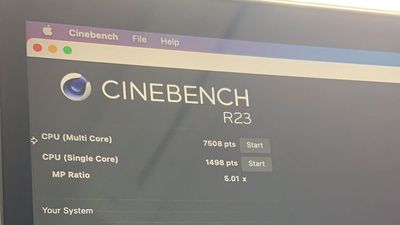
Comparatively, the high-end 2020 16-inch MacBook Pro with 2.3GHz Core i9 chip earned a multi-core score of 8818. The 2.6GHz low-end 16-inch MacBook Pro earned a single-core score of 1113 and a multi-core score of 6912 on the same test, and the high-end prior-generation MacBook Air earned a single-core score of 1119 and a multi-core score of 4329.
GPU
The 8-core GPU in the M1 chip is integrated (which means it is not a separate chip), and Apple calls it the world's fastest integrated graphics in a personal computer. It can execute 25,000 threads at a time and combines improved graphics performance with lower power consumption.
Neural Engine
There's a new, more advanced Neural Engine in the MacBook Air that is up to 9x faster for machine learning tasks. The Neural Engine has a 16-core design that can execute 11 trillion operations per second, and along with machine learning accelerators, it makes ML-based tasks much faster.
Apps like Final Cut Pro, Pixelmator, and others that use machine learning for video, photo, and audio editing purposes benefit from the Neural Engine.
No Fan
The MacBook Air does not have a fan for cooling purposes. Instead, an aluminum heat spreader dissipates heat, allowing for silent operation. That's one of the only internal changes in the new MacBook Air compared to older models.
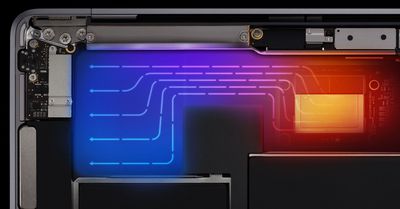
Running Apps
The M1 chip is built on an Arm architecture instead of an x86 architecture like Intel chips, but it will still run apps designed for Intel machines thanks to Rosetta 2, a translation process that runs in the background and is invisible to the user.
Apple is also encouraging developers to create Universal apps that use a single binary and run on both Apple Silicon Macs and Intel Macs. Further, Apple Silicon Macs are able to run apps that are designed for iPhone and iPad.
We have details on apps that have been updated with native or universal support, gaming on the M1 Macs, running homebrew apps, and more. Check out our M1 tidbits guide for details.
Battery Life
With the efficiency improvements introduced with the M1, the MacBook Air has impressive battery life that far exceeds the battery life of the prior-generation model.
The same 49.9WHr battery that was in the prior-generation model now lasts for up to 15 hours when browsing the web and up to 18 hours when watching a movie through the Apple TV app.
Efficiency Test
In a test compiling open source code for WebKit, Apple's M1 chip excelled. The M1 MacBook Pro and MacBook Air compiled the code more quickly than equivalent Intel based models, but more notably, still had 91 percent battery life remaining at the end of the test, while an Intel 13-inch MacBook Pro had just 24 percent battery life left.
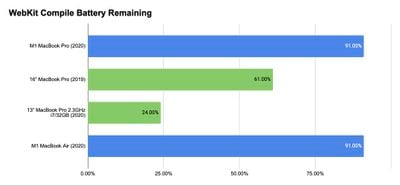
Other Features
Connectivity
The MacBook Air supports 802.11ax WiFi, which is known as Wi-Fi 6, a WiFi protocol that's faster and more efficient than the prior-generation 802.11ac WiFi. It also supports Bluetooth 5.0.
Speakers and Microphone
The MacBook Air features stereo speakers with wide stereo sound support for watching Apple TV+ content or playing iOS games and there's a three-array microphone with directional beamforming for FaceTime calls.
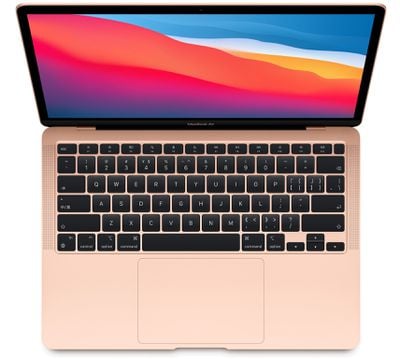
FaceTime Camera
There's a 720p HD camera built into the front of the MacBook Air for FaceTime calls. Apple has used a 720p front-facing camera for multiple years now and has not upgraded the quality, but this model's M1 chip allows for clearer, sharper images.
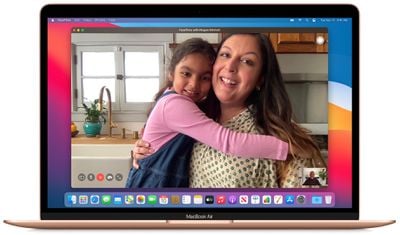
The M1 chip offers better noise reduction to pull more detail out of shadows and highlights, and the Neural Engine uses face detection to adjust white balance and exposure for more natural-looking skin tones.
Storage
The MacBook Air uses solid stage storage with capacities up to 2TB. Storage in the base level MacBook Air starts at 256GB, and the MacBook Air's SSD is up to 2x faster than the SSD in the prior-generation model.
SSD benchmarks have confirmed that the MacBook Air's SSD is indeed faster, hitting write speeds of 2190MB/s and read speeds of 2676MB/s. This is approximately twice as fast as the SSD in the prior-generation MacBook Air.
Technicians in China have discovered that the RAM and SSD in the M1 Mac can be upgraded after purchase, but this is something that's only been done in a test setting and these upgrades are not something the average person can undertake.
M1 MacBook Air
There are two stock 13-inch MacBook Air configurations available from Apple, in Silver, Space Gray, and Gold.
- $999 - M1 chip with 7-core GPU, 8GB RAM, 256GB SSD.
- $1249 - M1 chip with 8-core GPU, 8GB RAM, 512GB SSD.
Entry-level MacBook Air Upgrade Options:
- 16GB RAM - +$200
- 512GB SSD - +$200
- 1TB SSD - +$400
- 2TB SSD - +$800
Higher-end MacBook Air Upgrade Options:
- 16GB RAM - +$200
- 1TB SSD - +$200
- 2TB SSD - +$600
M1 Mac How Tos
MacBook Air (Late 2020): M1 Chip, 256 GB - Gold
N/A
$999.00
MacBook Air (Late 2020): M1 Chip, 256 GB - Silver
N/A
$999.00
MacBook Air (Late 2020): M1 Chip, 256 GB - Space Gray
N/A
$999.00
MacBook Air (Late 2020): M1 Chip, 512 GB - Gold
N/A
$1249.00
MacBook Air (Late 2020): M1 Chip, 512 GB - Silver
N/A
$1249.00
MacBook Air (Late 2020): M1 Chip, 512 GB - Space Gray
N/A
$1249.00
Apple Macbook Pro 15 2018 Apple Computer Graphic Design
Source: https://www.macrumors.com/roundup/macbook-air/
0 Response to "Apple Macbook Pro 15 2018 Apple Computer Graphic Design"
Post a Comment